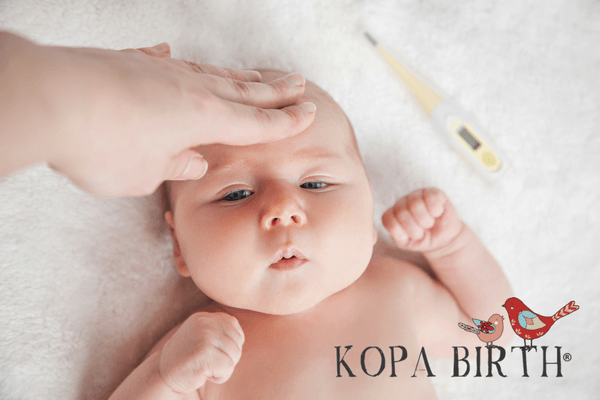
Estimated reading time: 5 minutes
Even the most experienced parents worry when their new baby seems to have a temperature. So, what is considered a fever for a baby? Let’s learn all about infant fevers and what to do if you think your baby has one.
A fever is the normal response that your baby’s body has to fighting infection. A fever will usually go away within 72 hours. While mild fevers are typically not concerning, fevers are considered more serious in babies who are 3 months and younger.
If your baby is 3 months and younger, The American Academy of Pediatrics suggests that parents call their pediatrician if baby has a rectal temperature of 100.4°F/38.0°C or higher (1).
A fever is often a symptom that your baby’s immune system is fighting off an illness. This can include a cold or an ear infection. Although less common, more serious infections such as pneumonia, meningitis, or an infection in baby’s blood from maternal Group B Streptococcus (GBS) can also cause a fever.
Another reason baby might have a fever is if he’s over-bundled or dressed too warmly. My husband and I had this happen once to our first baby when we put her to sleep for a nap wrapped in a polar fleece blanket. She woke up fevering and sweaty, and even threw up 🙁 . Fortunately she was fine afterwards, but it was a pretty awful lesson to learn. Infants have a hard time regulating their own temperatures, so they’re more prone to overheating. Since overheating is also a risk for SIDS (2), it’s best to skip heavy blankets and instead opt for light weight clothing and a light weight sleep sack.

Common symptoms that your baby might have a fever include:
There are a few different options to check your baby’s temperature for a fever. The most common methods are rectally, under the arm (axillary), or through the tympanic membrane (ear).
When considering all 3 options, we know that most children don’t like to have their temperature taken rectally. If this is the case with your baby, you can first take her temperature under her armpit or ear (if she’s old enough) to help you know generally whether or not she has a fever. If so, follow up by also taking a rectal temperature for a more exact reading.

Follow these simple tips to safely take your baby’s rectal temperature (4):
Kopa Birth’s online childbirth classes allow you to prepare for a natural childbirth from the comfort of your own home, 24/7. Enroll today in our free online childbirth class to learn more about preparing for a natural hospital birth.
References:
(1) American Academy of Pediatrics. (2010). Bright Futures parent Handout: 2 to 5 Day Visit. Retrieved from brightfutures org.
(2) American Academy of Pediatrics (2016). SIDS and Other Sleep-Related Infant Deaths: Updated 2016 Recommendations for a Safe Infant Sleeping Environment. Pediatrics, Volume 138, number 5.
(3) Hockenberry, M., Wilson, D. (2008). Wongs Nursing Care of Infants and Children. Elsevier, St. Louis, MO. pg 242
(4) How to take a child’s temperature. (2000). Paediatrics & Child Health, 5(5), 277–278.
Even the most experienced parents worry when their new baby seems to have a temperature. So, what is considered a fever for a baby? Let’s learn all about infant fevers